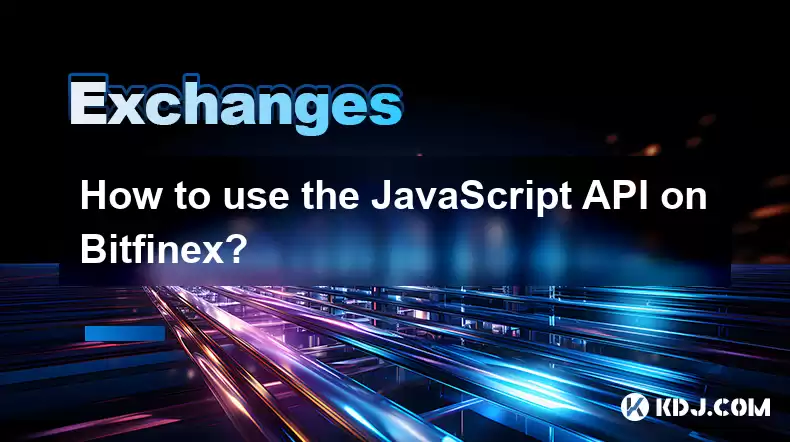-
 bitcoin
bitcoin $87959.907984 USD
1.34% -
 ethereum
ethereum $2920.497338 USD
3.04% -
 tether
tether $0.999775 USD
0.00% -
 xrp
xrp $2.237324 USD
8.12% -
 bnb
bnb $860.243768 USD
0.90% -
 solana
solana $138.089498 USD
5.43% -
 usd-coin
usd-coin $0.999807 USD
0.01% -
 tron
tron $0.272801 USD
-1.53% -
 dogecoin
dogecoin $0.150904 USD
2.96% -
 cardano
cardano $0.421635 USD
1.97% -
 hyperliquid
hyperliquid $32.152445 USD
2.23% -
 bitcoin-cash
bitcoin-cash $533.301069 USD
-1.94% -
 chainlink
chainlink $12.953417 USD
2.68% -
 unus-sed-leo
unus-sed-leo $9.535951 USD
0.73% -
 zcash
zcash $521.483386 USD
-2.87%
How to use the JavaScript API on Bitfinex?
The Bitfinex JavaScript API enables developers to trade, retrieve market data, and manage accounts programmatically, requiring setup with API keys and Node.js.
Apr 25, 2025 at 07:28 am

Using the JavaScript API on Bitfinex allows developers to interact programmatically with the Bitfinex exchange, enabling them to perform tasks such as trading, retrieving market data, and managing accounts. This article will guide you through the process of setting up and using the Bitfinex JavaScript API, ensuring you understand each step in detail.
Setting Up the Bitfinex API
Before you can start using the Bitfinex JavaScript API, you need to set up your environment and obtain the necessary API keys. Here's how you can do that:
- Visit the Bitfinex website and log into your account.
- Navigate to the API section under your account settings.
- Create a new API key. You will need to provide a label for the key and set the permissions according to your needs.
- Save the API key and secret. These are crucial for authenticating your API requests.
Once you have your API key and secret, you can proceed to set up your development environment. You'll need Node.js installed on your machine to use the Bitfinex JavaScript API.
- Install Node.js if you haven't already. You can download it from the official Node.js website.
- Create a new directory for your project and navigate to it in your terminal or command prompt.
- Initialize a new Node.js project by running
npm initand following the prompts. - Install the Bitfinex API library by running
npm install bitfinex-api-node.
Authenticating with the Bitfinex API
To interact with the Bitfinex API, you need to authenticate your requests using the API key and secret you obtained earlier. Here's how to set up authentication:
- Import the Bitfinex API library in your JavaScript file. You can do this by adding
const bfx = require('bitfinex-api-node')at the top of your file. - Create a new Bitfinex client by calling
const client = new bfx({ apiKey: 'YOUR_API_KEY', apiSecret: 'YOUR_API_SECRET' }). - Open a connection to the Bitfinex WebSocket by calling
client.open(). This will allow you to send and receive real-time data.
Retrieving Market Data
One of the primary uses of the Bitfinex API is to retrieve market data, such as ticker information, order books, and trade histories. Here's how you can do that:
- Get ticker information for a specific trading pair by using the
tickermethod. For example, to get the ticker for the BTC/USD pair, you would useclient.rest(2, 'ticker', 'tBTCUSD', (error, data) => { if (error) { console.error(error); } else { console.log(data); } });. - Retrieve the order book for a trading pair by using the
bookmethod. For example, to get the order book for the BTC/USD pair, you would useclient.rest(2, 'book', 'tBTCUSD', { len: 100 }, (error, data) => { if (error) { console.error(error); } else { console.log(data); } });. - Fetch trade history for a trading pair by using the
tradesmethod. For example, to get the trade history for the BTC/USD pair, you would useclient.rest(2, 'trades', 'tBTCUSD', { limit: 100 }, (error, data) => { if (error) { console.error(error); } else { console.log(data); } });.
Placing and Managing Orders
The Bitfinex API also allows you to place and manage orders programmatically. Here's how you can do that:
- Place a new order by using the
newOrdermethod. For example, to place a market buy order for 0.1 BTC at the current market price, you would useclient.rest(2, 'order/new', { type: 'EXCHANGE MARKET', symbol: 'tBTCUSD', amount: '0.1', price: '0' }, (error, data) => { if (error) { console.error(error); } else { console.log(data); } });. - Cancel an existing order by using the
order/cancelmethod. For example, to cancel an order with the ID12345, you would useclient.rest(2, 'order/cancel', { order_id: '12345' }, (error, data) => { if (error) { console.error(error); } else { console.log(data); } });. - Retrieve your active orders by using the
ordersmethod. For example, to get all your active orders, you would useclient.rest(2, 'orders', {}, (error, data) => { if (error) { console.error(error); } else { console.log(data); } });.
Managing Your Account
In addition to trading and retrieving market data, the Bitfinex API allows you to manage your account, including checking your balances and withdrawing funds. Here's how you can do that:
- Check your account balances by using the
balancesmethod. For example, to get your current balances, you would useclient.rest(2, 'auth/r/wallets', {}, (error, data) => { if (error) { console.error(error); } else { console.log(data); } });. - Withdraw funds by using the
withdrawmethod. For example, to withdraw 0.1 BTC to a specific address, you would useclient.rest(2, 'auth/w/withdraw', { wallet: 'exchange', method: 'bitcoin', amount: '0.1', address: 'YOUR_BTC_ADDRESS' }, (error, data) => { if (error) { console.error(error); } else { console.log(data); } });.
Handling Errors and Exceptions
When working with the Bitfinex API, it's important to handle errors and exceptions properly to ensure your application remains stable. Here's how you can do that:
- Use error callbacks in your API calls to catch and handle errors. For example, in the
tickermethod call, theerrorparameter in the callback function allows you to handle any errors that occur. - Implement retry logic for transient errors. If an API call fails due to a temporary issue, you can implement a retry mechanism to attempt the call again after a short delay.
- Log errors for debugging purposes. By logging errors, you can track down issues and improve your application's reliability.
Frequently Asked Questions
Q: Can I use the Bitfinex JavaScript API for automated trading?A: Yes, the Bitfinex JavaScript API can be used for automated trading. You can write scripts that place orders, monitor market conditions, and execute trades based on predefined strategies.
Q: Is there a rate limit on API requests to Bitfinex?A: Yes, Bitfinex imposes rate limits on API requests to prevent abuse. The specific limits depend on the type of request and your account's tier. You should check the Bitfinex documentation for the most up-to-date information on rate limits.
Q: How can I secure my API keys when using the Bitfinex JavaScript API?A: To secure your API keys, you should never hardcode them in your scripts. Instead, use environment variables or a secure configuration management system to store and retrieve your keys. Additionally, limit the permissions of your API keys to only what is necessary for your application.
Q: Can I use the Bitfinex JavaScript API to trade on multiple exchanges simultaneously?A: The Bitfinex JavaScript API is specific to the Bitfinex exchange and cannot be used to trade on other exchanges directly. However, you can write a script that uses multiple exchange APIs to trade on different platforms simultaneously.
Disclaimer:info@kdj.com
The information provided is not trading advice. kdj.com does not assume any responsibility for any investments made based on the information provided in this article. Cryptocurrencies are highly volatile and it is highly recommended that you invest with caution after thorough research!
If you believe that the content used on this website infringes your copyright, please contact us immediately (info@kdj.com) and we will delete it promptly.
- Avalanche Foundation Pivots to Institutional Capital, Embracing US Treasuries Amidst Market Evolution
- 2025-12-29 04:15:01
- XRP Price Outlook for 2026: Analysts Eye Consolidation Breakout Amidst Shifting Market Dynamics
- 2025-12-29 04:20:01
- XRP Price Under Siege: Analysts Point to Deepening Bearish Breakdown Amidst Market Volatility
- 2025-12-29 03:50:02
- SSV Network Steers Ethereum's Future: The Decentralized Staking Revolution Hits Full Stride
- 2025-12-29 04:10:01
- New York Regulators Unmask AI Trading Scams, Exposing Perils for Eager Investors
- 2025-12-29 04:10:01
- Meme Coins, January 2026, Cryptocurrency: NYC's Take on the Digital Wild West
- 2025-12-29 04:15:01
Related knowledge

How to find your Bybit deposit address?
Dec 26,2025 at 02:39pm
Accessing Your Bybit Deposit Interface1. Log in to your Bybit account using your registered credentials or biometric authentication if enabled. 2. Nav...

A full review of the Bybit NFT Marketplace.
Dec 28,2025 at 08:20pm
Platform Overview1. Bybit NFT Marketplace launched in early 2022 as a dedicated digital asset trading venue integrated directly into the Bybit ecosyst...

What are the benefits of being a VIP on Bybit?
Dec 27,2025 at 11:40am
VIP Tier Structure and Eligibility1. Bybit assigns VIP status based on a user’s 30-day average net asset value, calculated from the sum of assets held...

How to trade altcoins on the Bybit spot market?
Dec 25,2025 at 05:39am
Accessing the Bybit Spot Market Interface1. Log in to your Bybit account using verified credentials and two-factor authentication. 2. Navigate to the ...

Bybit "Order submission failed" error: How to fix it?
Dec 26,2025 at 08:20pm
Troubleshooting the Order Submission Failed Error1. The error message “Order submission failed” on Bybit commonly appears when a user attempts to plac...

What are perpetual contracts on Bybit? An easy explanation.
Dec 27,2025 at 11:39pm
What Are Perpetual Contracts?1. Perpetual contracts are derivative instruments that track the price of an underlying asset—such as Bitcoin or Ethereum...

How to find your Bybit deposit address?
Dec 26,2025 at 02:39pm
Accessing Your Bybit Deposit Interface1. Log in to your Bybit account using your registered credentials or biometric authentication if enabled. 2. Nav...

A full review of the Bybit NFT Marketplace.
Dec 28,2025 at 08:20pm
Platform Overview1. Bybit NFT Marketplace launched in early 2022 as a dedicated digital asset trading venue integrated directly into the Bybit ecosyst...

What are the benefits of being a VIP on Bybit?
Dec 27,2025 at 11:40am
VIP Tier Structure and Eligibility1. Bybit assigns VIP status based on a user’s 30-day average net asset value, calculated from the sum of assets held...

How to trade altcoins on the Bybit spot market?
Dec 25,2025 at 05:39am
Accessing the Bybit Spot Market Interface1. Log in to your Bybit account using verified credentials and two-factor authentication. 2. Navigate to the ...

Bybit "Order submission failed" error: How to fix it?
Dec 26,2025 at 08:20pm
Troubleshooting the Order Submission Failed Error1. The error message “Order submission failed” on Bybit commonly appears when a user attempts to plac...

What are perpetual contracts on Bybit? An easy explanation.
Dec 27,2025 at 11:39pm
What Are Perpetual Contracts?1. Perpetual contracts are derivative instruments that track the price of an underlying asset—such as Bitcoin or Ethereum...
See all articles










































































